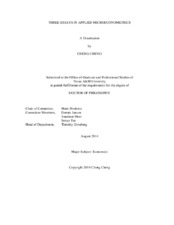| dc.description.abstract | This dissertation analyzes the effects of three public policies using quasi-experimental methods. These policies include U.S. cell phone bans that prevent drivers from using cell phones while driving, U.S. castle doctrine laws that justify using lethal force in self-defense situations, and China’s marriage registration reform that simplifies the marriage and divorce process.
I first examine if cell phone bans change driver behavior. Using data on observed driver cell phone usage combined with a difference-in-differences approach that exploits the within-state variation in the adoption of bans, I find prohibiting drivers from texting and talking on handheld cell phones reduces each by 60 and 50 percent, respectively. This suggests the policy is effective at reducing the targeted behavior. Combined with findings that show cell phone bans do not reduce traffic accidents and casualties, I further discuss other factors and behavioral responses that may counteract the reduction in observed usage.
Next, I investigate if castle doctrine laws deter crime or escalate violence by lowering the expected cost of using lethal force and increasing the expected cost of committing violent crime. Using a similar difference-in-differences strategy, I find the laws do not deter burglary, robbery, or aggravated assault. In contrast, they lead to a statistically significant 8 percent net increase in the number of reported murders and non-negligent manslaughters.
Finally, I evaluate the marital consequences of easier access to divorce and marriage by exploiting a major policy change in China that simplify both. To distinguish the causal effect from the effect of other confounding factors, I use a regression discontinuity design to compare annual changes in divorce and marriage rates just before and just after the adoption of the 2003 Regulations on Marriage Registration. Results indicate that lower cost of divorce and marriage immediately triggered faster growth in divorce and marriage rates. | en |


